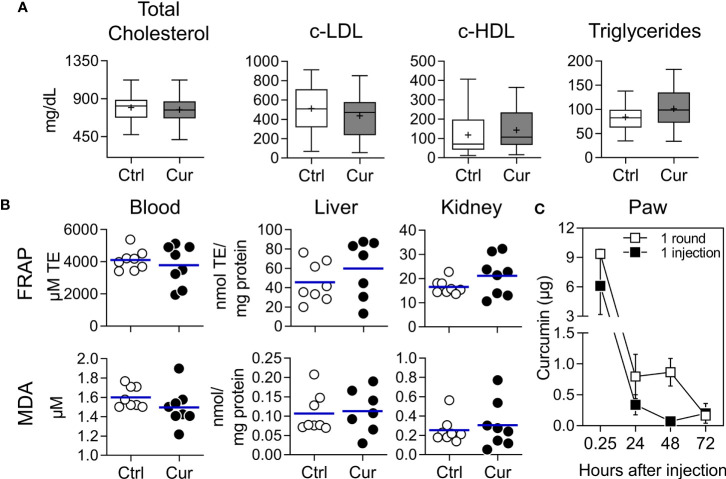Figure 2.
Absence of systemic lipid-lowering or antioxidant effects in ApoE-/- mice treated with subcutaneous microdose curcumin. (A, B) Dyslipidemic ApoE-/- mice were treated with curcumin (Cur) or vehicle (Ctrl) as shown in Figure 1A . (A) Total cholesterol, c-LDL, c-HDL, and triglycerides were measured in serum samples at the end of the experiment. (B) The antioxidant effect of curcumin in vivo was assessed by preparing blood, liver and kidney homogenates and evaluating the antioxidant capacity with the FRAP method (upper panel) or quantifying the concentration of the lipid peroxidation products MDA (lower panel) for each matrix. Results presented in (A) correspond to two pooled experiments (n=27 mice/group) and plotted as box and whiskers. Results in (B) correspond to one experiment (n=7-8 mice/group) and each dot represents an individual animal and the line the mean for each group. (A, B) Mann-Whitney U test was performed resulting in the two treatment groups not being statistically different at any measurement. (C) For the biodistribution experiment, groups of WT C57BL/6 mice were injected sc with curcumin (10 µg) in the hind footpad, euthanized ¼, 24, 48 and 72 h after one injection or one round of treatment (see Figure 1A ), and the amount of curcumin recovered from the whole paw, dLN and serum homogenates was determined by fluorescence spectrometry (see Materials and Methods for details). Mice injected with vehicle were used as blanks. Results are presented as mean ± SEM for each timepoint (n=3). Curcumin amounts in dLN and serum samples were below the limit of quantification of the technique (0.1 µg; data not shown).

